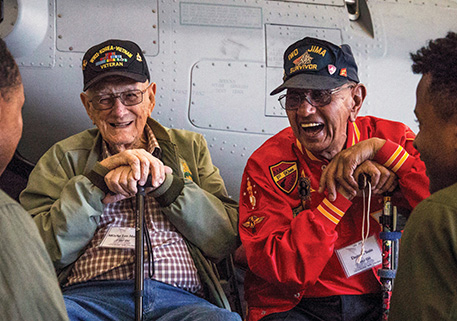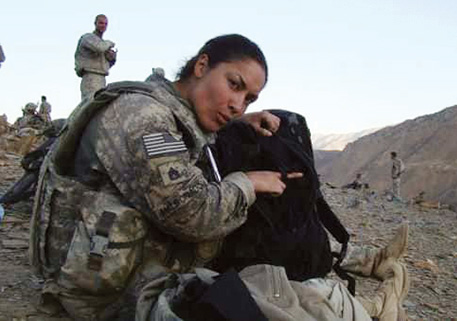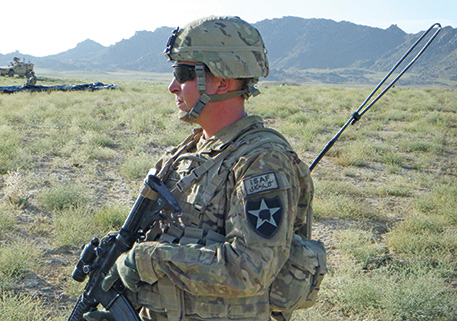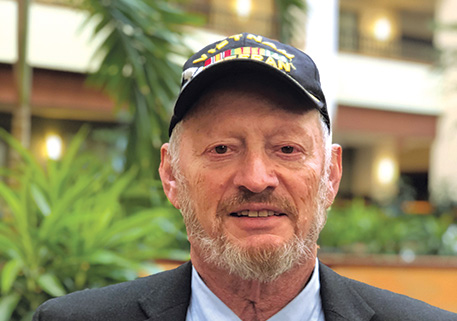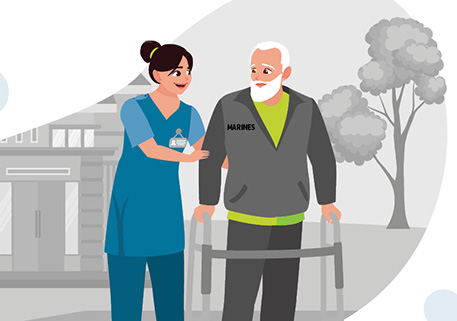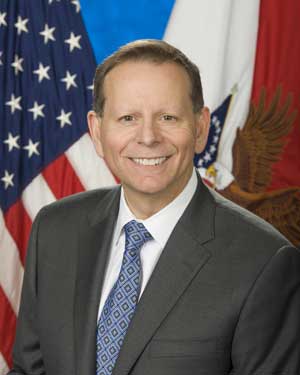
Veterans Benefits Administration head discusses benefits issues
DAV recently had the opportunity to speak with the Department of Veterans Affairs’ undersecretary for benefits, Dr. Paul R. Lawrence, regarding a wide range of issues facing the Veterans Benefits Administration (VBA), including his priorities and challenges. The following interview has been edited for clarity.
DAV: Why were you interested in becoming the VA’s undersecretary for benefits?
Dr. Lawrence: I was raised in an Army family; my father served 24 years and was in the Korean and Vietnam wars. He taught me many valuable leadership lessons, but the one that has consistently guided me was “mission first and men always.” He is buried in Section 66 of Arlington National Cemetery. My 93-year-old mother came from a large family—11 brothers and sisters. Five of her brothers answered the call and served in the armed forces during World War II. My middle name, Reynold, was given to me in honor of her only brother who didn’t return, killed at Normandy.
My brother and I both were commissioned into the Army through ROTC. After graduate school, I served on active duty in the Army in the Finance Corps. I left as an airborne-qualified captain and received the Meritorious Service Medal. For most of my professional career, I have worked as a consultant in large professional services firms helping federal government leaders improve efficiency and effectiveness. I have firsthand experience with opportunities and management challenges similar to those facing VBA.
What is differentiating about my experiences as a consultant to the federal government is I have conducted extensive research and thought leadership into how government is managed by senior leaders and I am applying many of these best practices. I am passionate about veterans’ issues and want to contribute to the efforts to improve the support provided to veterans by the VA.
DAV: What are your priorities?
Dr. Lawrence: When I arrived in June of this year, I introduced three priorities to achieve greater success for our veterans.
The first is to provide veterans with the benefits they have earned in a manner that honors their service. We will make organizational improvements so we are more efficient for our veterans and ensure they walk away from their VBA experiences with high customer satisfaction. We’re really focused on transition. Leaving the military and entering civilian life can be a really trying time. So one thing we did as soon as I came on board was to collaborate with VSOs, DOD, DOL and ED to establish the Office of Transition and Economic Development to improve veterans’ educational and career prospects when they transition out of the military or when they need support in their civilian life. We’ll provide counseling and other programs designed to position veterans for economic success.
The second is to ensure strong fiscal stewardship of the money entrusted to us by taxpayers. We are going to focus on identifying and avoiding potential fraud, waste and abuse and reducing improper payments, while increasing communication to veterans who are affected.
And third is to foster a culture of collaboration. I want to be constantly engaging with our veterans and those who support our veterans—such as DAV, the traditional VSOs, post-9/11 veterans groups, state and county VSOs, Congress, GAO, IG, OMB and other federal agencies. I’ve already heard a lot of ideas about how we can all work together to support and take care of our veterans, and I’m looking forward to doing more of that. I know that VA can’t do it alone.
DAV: What do you see as the biggest challenges you will face?
Dr. Lawrence: Some of the challenges we faced in fiscal year (FY) 2018 include changes in VBA leadership. Anytime there is a change in leadership, there are challenges by definition. I started in May 2018, so I’ve been on the job for a number of months now. In that time, I’m happy to report that I’ve witnessed a strong, engaged leadership team, equal to or frankly better than elsewhere in government, and I’m confident we’ll meet our goals to serve our veterans as best we can. We’re constantly looking at ourselves to streamline processes and reallocate resources so we can serve veterans better.
As for specific challenges, I see the biggest as fully implementing the Appeals Modernization Act, implementing the Forever GI Bill, and processing military sexual trauma (MST) claims that respects those who served.
Appeals reform is one of the most significant changes in decades to affect VA and the veterans it serves. Before reform, veterans who filed an appeal of their disability claims experienced a complex, nonlinear process that was buried in several layers of law. Veterans deserve an appeal process that is simple, timely, transparent and fair.
Due to close collaboration between VA, Congress, veteran service organizations and advocates, the Appeals Modernization Act created a new system featuring three processing lanes: higher-level review, supplemental claim and appeal to the Board of Veterans’ Appeals (BVA). Veterans with an active appeal can now choose between the three lanes by participating in the Rapid Appeals Modernization Program (RAMP). Implementation of the first two appeal lanes began with VBA in November 2017, and the third lane was established within the Board in October 2018. Full implementation of the law is expected in February 2019.
The next challenge was the implementation of the Forever GI Bill. Part of the difficulty of implementing this new law was information technology, specifically related to changing the way VA pays monthly housing stipends for GI Bill recipients. On the technology front, our efforts have been slower than planned. That has resulted in processing manually using last year’s monthly allowance. To address the issue, we mobilized additional employees who can process claims to do this—even if they are assigned to other duties—and we hired additional employees to address it. We continue to carefully monitor how long veterans are waiting for their payments and prioritizing those who have been waiting the longest. We understand the burden and hardship this places on veterans. This is one of our top issues, and we are working it intensely.
Processing MST claims in a manner that respects those who served is another challenge. For men and women who have experienced MST, the results can be devastating. We handle MST-related cases with great care, but we know this is an area where we can improve even further. In August 2018, the VA inspector general issued a report on post-traumatic stress disorder as a result of MST, indicating that we could do better on MST claims. We are implementing all their recommendations. We’re updating MST training, focusing on quality and accuracy of MST claims, and reviewing previously decided MST claims from FY17 through FY19, and correcting if necessary. We know this is important, so we’re refocusing our efforts to make sure we get this right.
DAV: The number of pending claims, as well as those pending more than 125 days that are considered backlogged, dropped dramatically from 2009 to 2014 as VBA underwent significant transformation of its people, processes and technology. However, over the past couple of years, the reduction of the backlog slowly tapered off and has now begun to slowly rise over the past year.
What are the reasons for this increase, what plans does VBA have to reverse this trend, and can the backlog be eliminated completely in the future?
Dr. Lawrence: Over the past 15 years, the number and complexity of these claims continues to increase as more and more veterans and family members are coming to VA for help. For the 10th year in a row, we received over 1 million claims (1.4 million in FY18), and completed over 1.3 million claims and 6.5 million issues this past year. To place this issue in context, VA is paying an estimated 5.6 million veterans and beneficiaries more than $88.4 billion in compensation and pension benefits—a historic high—as of the end of FY18.
VBA is committed to providing veterans with the benefits they have earned in a way that honors their service. While there has been a slight increase in the number of claims pending longer than 125 days in the inventory on an annual basis, VBA continues to make significant improvements in timely and accurate service. In FY18, the average number of days to complete a disability rating claim was 99 days, a 14-day improvement (12 percent decrease) from FY17 and 22-day improvement (18 percent decrease) from FY16. Furthermore, in FY18, VBA completed 76 percent of all rating claims in less than 125 days, a 31 percent improvement from FY15, when less than half of the claims were completed in less than 125 days. These improvements were made while also demonstrating high fiscal stewardship, reducing overtime expenses by $24 million.
VBA has taken a more diversified approach to workload management. Through FY15, VBA resources were heavily dedicated to completing disability rating claims. From FY16 to FY18, the overall inventory of these claims has stabilized at approximately 350,000 to 360,000 pending claims, with approximately 22 to 24 percent of the total inventory pending over 125 days. This stabilization has allowed VBA to increase focus on nonrating work, which includes adjustments to benefit payments to reduce improper payments. Additionally, VBA has dedicated additional resources in advance of the February 2019 implementation date for the new appeals process and the completion of pending appeals in our legacy appeals process.
VBA continues to explore and implement ways to make its disability rating claims process responsive to veterans’ needs and simpler for our employees to use, thereby ensuring high-quality, timely delivery of benefits and services. Even with VBA’s transformation and continual process improvements, several factors may prolong processing beyond the 125-day timeframe that was established in 2009. The agency’s decision-makers are accountable for ensuring the claim file contains all identified evidence and are required to delay processing where such evidence is missing and a grant of benefits is not possible. In these cases, longer processing time ensures thorough development and more accurate outcomes.
DAV: We who represent veterans in their claims work are an integral partner with VBA in helping to arrive at timely and accurate decisions. DAV and other veterans groups have also worked closely with VBA and the Board over the past several years helping to reform and modernize the claims and appeals processing systems.
How do you view the role of veterans service organizations and, in particular, what role can and should they have as VBA continues to design and implement new IT systems and work processes?
Dr. Lawrence: First, I want to thank the dedicated people at DAV, who always support our veterans, ensuring that they receive the benefits and service they have earned. Veteran service organizations are an extremely important and integral partner in honoring those men and women who have served this country throughout our history.
As I mentioned earlier, one of my top priorities is close collaboration with our stakeholders, especially the VSOs. As the undersecretary, I know that VA cannot comprehensively serve veterans alone. It is imperative that we work together. I remain committed to creating an open and honest dialogue with all those who have the best interests of our veterans and their families at heart.
Personally, since I’ve been in office, I’ve been to several of our VA regional offices. I’m meeting with VSOs regularly, to include going to their conferences throughout the year. And I’m engaging with veterans directly. I am committed to further developing these relationships and to always being open, collaborative and transparent. We’re doing regular engagement with our veterans organizations across the country, with a special focus on certain groups such as minority veterans, women veterans, homeless veterans and many others. All told, VBA has conducted approximately 6,000 total outreach events for veterans in FY18, where we interacted with about 5 million veterans.
How can VBA and VSOs work better together to improve service to veterans? This is something I have been thinking about since I arrived. We conducted a series of interviews with VSOs to get their feedback on this topic. We agreed to work together in three areas to do this: improve the communication we do to veteran service organizations, veterans and their family members; provide better access to our systems for VSOs when they’re supporting veterans; and work with VSOs to engage more with our nontraditional segments of the veteran population.
DAV: The Appeals Improvement and Modernization Act of 2018 is required to be fully implemented in February 2019. The VA introduced RAMP to pilot test the new appeals process. The proposed regulatory provisions defining the process were published in August.
Will VBA and the Board of Veterans’ Appeals be prepared for full implementation in February 2019? And when do you think veterans with appeals pending will begin to see the impact of the new appeals system?
Dr. Lawrence: Yes, VBA and the Board are on track to fully implement the act in February. Veterans are already seeing the impact of the new process by way of RAMP, a program created to give veterans awaiting decision on their appeals early access to the new decision review process.
VBA’s appeals inventory is down 47,000 from last year. This is a tremendous accomplishment by our VBA appeals team, especially given the fact that they’re preparing for the implementation of the Appeals Modernization Act. It is our plan to resolve all the appeals we received before the act, which we call legacy appeals, by the end of 2020.
As of Oct. 18, more than 55,000 veterans have opted into the program, resulting in the transition of almost 66,000 appeals from the current system into RAMP. Veterans are receiving RAMP decisions in an average of 112 days, and VA has paid more than $95.5 million in retroactive benefit payments to date. This is a significant improvement over the legacy process, which typically takes three to seven years to resolve appeals.
Additionally, the Board decides appeals that are elevated beyond VBA, and we work closely with them. They’re happy to report, and I’m happy to share, that they completed 85,000 decisions in FY18—a historic record and 62 percent more than last year.
VA remains deeply committed to helping veterans receive the benefits they have earned in a manner that honors their service and fosters a culture of collaboration with all our stakeholders. Both the Board and VBA have a comprehensive workforce plan to recruit, hire and train new employees, as well as implement new processes and technology into the appeals system. I encourage veterans to go to our website at benefits.va.gov to find more information about the Appeals Modernization Act and RAMP.
DAV: The National Academy of Medicine, formerly called the Institute of Medicine (IOM), published the 2014 update to its Veterans and Agent Orange study in 2016. The study noted that, based on the entire body of evidence, it changed the categories of association with exposure to herbicides in Vietnam for three health effects. IOM found that bladder cancer and hypothyroidism have “limited or suggestive” evidence of an association. Further, the study clarified that Vietnam veterans with Parkinson’s-like symptoms, but without a formal diagnosis of Parkinson’s disease, should be considered under the presumption that Parkinson’s disease and the veterans’ are service-connected. In late 2017, the VA issued a press release noting they were exploring new presumptive conditions related to herbicide exposure for service connection.
What is the status of the VA adding these three new presumptive diseases related to herbicide exposure?
Dr. Lawrence: Because of the expiration of the Agent Orange Act, VA must now use its own authority to add any new disabilities to the Agent Orange presumptive list. This process differs from adding new presumptive conditions under the Agent Orange Act because it is not congressionally mandated. There were four conditions listed in the latest report as having limited or suggestive evidence of an association with Agent Orange exposure that have not yet been added as presumptive conditions. However, VA has already made a decision on hypertension and published that decision in the Federal Register in 2010, 2012 and again in 2014, after each report by the National Academy. A final decision on whether or not to add new Agent Orange presumptive disabilities has not been made. Secretary Wilkie, having been recently appointed, is currently reviewing the medical and scientific evidence surrounding this issue, including the report by the National Academy. The secretary will publicly announce the decision as soon as this review is complete.
DAV: In August, the VA Office of the Inspector General (OIG) published its report finding that in fiscal year 2017, VBA staff did not properly process approximately 49 percent of veterans’ claims for post-traumatic stress disorder related to military sexual trauma (MST). The OIG made six recommendations for improving VBA’s process and procedures concerning MST-related PTSD claims.
Can you describe the actions and plans VBA has taken to address OIG’s recommendations?
Dr. Lawrence: VA strives to handle MST-related cases accurately, in a timely manner and with compassion. Although earlier efforts surrounding MST-related claims resulted in great improvement, notably in increased grant rates, we realize that there is more room for improvement in how these cases are processed. In implementing all of OIG’s recommendations, VA is taking immediate and comprehensive action. Along with updating MST training, focusing on quality and accuracy of MST claims, we are reviewing every previously decided MST claim from October 2016 through June 2018. Because VA wants to ensure that these claims continue to be processed with compassion, we are ensuring they are only handled by specialized claim processors who are trained in MST-related claims and who handle them on a regular basis. VA will also ensure that these claims are decided correctly by having a second-level review. We will also continue to review and focus on these claims, with a special review already scheduled for late 2019. These efforts will maintain our focus on MST-related claims and ensure they are correctly handled by VA.
VA is taking immediate and comprehensive actions in response to OIG’s recommendations to improve the processing and handling of MST claims. VA strives to provide accurate and timely benefits to all veterans. Due to the sensitive nature of MST claims, VA must provide compassionate assistance to affected veterans in gathering all necessary evidence to fairly and accurately decide their claims. To ensure high priority and complex claims continue to receive special emphasis, VA is in the process of designating specialized groups of trained veterans service representatives and rating veterans service representatives.
DAV: In August, the VA OIG published its report finding that VBA staff did not always assign correct effective dates for compensation benefits with Intent to File (ITF) submissions. OIG estimated that claimants were underpaid approximately $72.5 million in benefits.
What actions has VBA taken to address the OIG recommendations? And has the VA planned or is VA planning to make payments to correct these underpayments?
Dr. Lawrence: OIG recognized in its report that these errors were a result of VA’s long-needed efforts to update its capabilities from an antiquated paper-based system to a modern, electronic claim processing system. This was not always a smooth transition. VA had recognized issues related to the ITF process and had proactively taken steps to begin addressing these issues prior to the OIG review. Specifically, we took action to update our guidance to claim processors and to develop an IT solution. VA continues to move forward to update its IT systems to assist claim processors with assigning correct effective dates related to ITF claims. VA is also in the process of reviewing data related to the claims OIG reviewed to determine whether any corrective action is necessary. VA’s actions related to this OIG review will ensure veterans are paid the benefits to which they are entitled, while also ensuring that VA is a good steward of taxpayer dollars.

